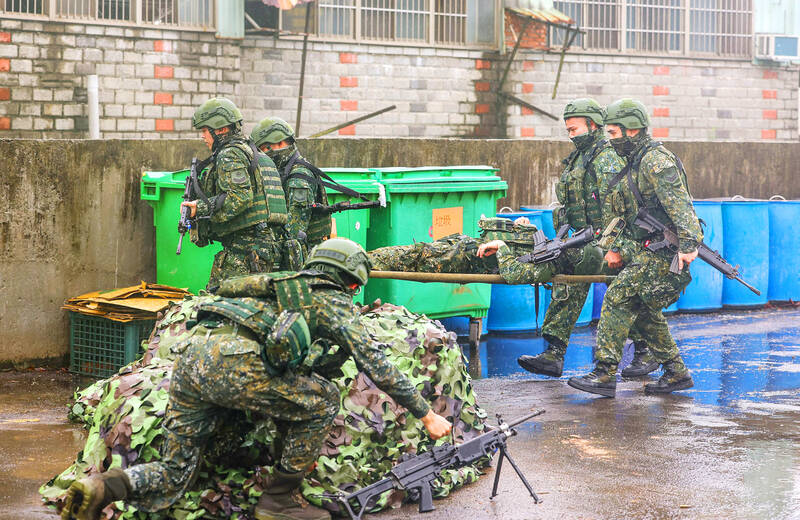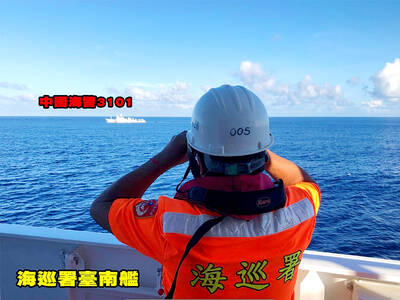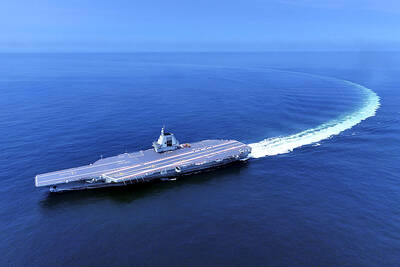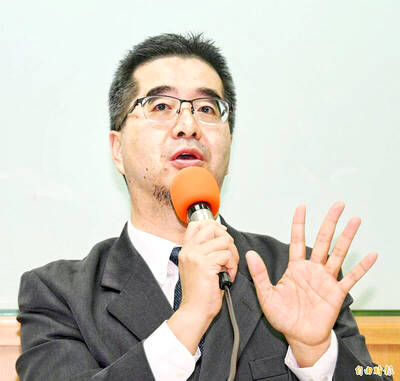Disaster relief efforts in southern Taiwan yesterday took units participating in the Han Kuang military exercises out of drill mode, while others set up defensive structures as the simulated war games entered their third day.
The first three days of the drills focused on countering China’s “gray zone” tactics — coercive actions that fall short of open conflict — the Ministry of National Defense said last week.
Naval units on Thursday deployed anti-ship missiles and the air force practiced “hot refueling,” while the army conducted a drill simulating Chinese operations aimed at seizing control of Taiwan Taoyuan International Airport and civil defense mechanisms were activated, such as emergency air-raid drills at PX Mart stores.

Photo: Cheng I-hwa, AFP
Yesterday, ground units mobilized resources and prepared fortifications.
More than 3,000 reservists from the army’s 206th Infantry Brigade simulated the defense of critical supplies against a Chinese attack on a logistics site in Taoyuan.
The entire brigade was mobilized for the Han Kuang exercises for the first time this year, military officials said.

Photo: Ann Wang, Reuters
Yellow, red and green smoke grenades simulated enemy contact, counterattacks and communication disruptions at the logistics site prompting soldiers’ responses.
The soldiers protected transportation and logistics supply points while others evacuated mock casualties.
To enhance the realism of the exercise, the military set up speakers that broadcast the sounds of explosions, and rifle and machine-gun fire to create a more realistic battlefield environment.
In an after-action review, officers told soldiers that upon receiving reports of enemy activity, they need to move quickly to their tactical positions and maintain vigilance in the direction of the incoming threat.
Soldiers should avoid areas where there are overlapping fields of fire, the officers said.
Chieh Chung (揭仲), a researcher at the Association of Strategic Foresight who observed the exercises in Taoyuan, praised the reservist training and its effectiveness in transforming civilians into mission-ready soldiers.
The training scenario was “highly necessary,” as it simulated potential enemy attacks on ammunition supply points and storage sites, Chieh said.
After an inventory of personnel and materiel, the engineering corps constructed defensive works at a site in central Taiwan, while there were reports that fortification exercises were also held in the nation’s south.
In addition to mobilizing military and civilian resources, some units in southern Taiwan assisted with disaster recovery efforts after Typhoon Danas struck the region on Sunday.
The Tainan City Government on Thursday announced that the city’s urban resilience drills scheduled for Wednesday next week would be canceled to prioritize disaster relief and reconstruction efforts, while the Chiayi city and county governments canceled drills on Tuesday next week.

The Coast Guard Administration (CGA) yesterday said it had deployed patrol vessels to expel a China Coast Guard ship and a Chinese fishing boat near Pratas Island (Dongsha Island, 東沙群島) in the South China Sea. The China Coast Guard vessel was 28 nautical miles (52km) northeast of Pratas at 6:15am on Thursday, approaching the island’s restricted waters, which extend 24 nautical miles from its shoreline, the CGA’s Dongsha-Nansha Branch said in a statement. The Tainan, a 2,000-tonne cutter, was deployed by the CGA to shadow the Chinese ship, which left the area at 2:39pm on Friday, the statement said. At 6:31pm on Friday,

The Chinese People’s Liberation Army Navy’s (PLAN) third aircraft carrier, the Fujian, would pose a steep challenge to Taiwan’s ability to defend itself against a full-scale invasion, a defense expert said yesterday. Institute of National Defense and Security Research analyst Chieh Chung (揭仲) made the comment hours after the PLAN confirmed the carrier recently passed through the Taiwan Strait to conduct “scientific research tests and training missions” in the South China Sea. China has two carriers in operation — the Liaoning and the Shandong — with the Fujian undergoing sea trials. Although the PLAN needs time to train the Fujian’s air wing and

Taiwanese celebrities Hank Chen (陳漢典) and Lulu Huang (黃路梓茵) announced yesterday that they are planning to marry. Huang announced and posted photos of their engagement to her social media pages yesterday morning, joking that the pair were not just doing marketing for a new show, but “really getting married.” “We’ve decided to spend all of our future happy and hilarious moments together,” she wrote. The announcement, which was later confirmed by the talent agency they share, appeared to come as a surprise even to those around them, with veteran TV host Jacky Wu (吳宗憲) saying he was “totally taken aback” by the news. Huang,

The American Institute in Taiwan (AIT) put Taiwan in danger, Ma Ying-jeou Foundation director Hsiao Hsu-tsen (蕭旭岑) said yesterday, hours after the de facto US embassy said that Beijing had misinterpreted World War II-era documents to isolate Taiwan. The AIT’s comments harmed the Republic of China’s (ROC) national interests and contradicted a part of the “six assurances” stipulating that the US would not change its official position on Taiwan’s sovereignty, Hsiao said. The “six assurances,” which were given by then-US president Ronald Reagan to Taiwan in 1982, say that Washington would not set a date for ending arm sales to Taiwan, consult